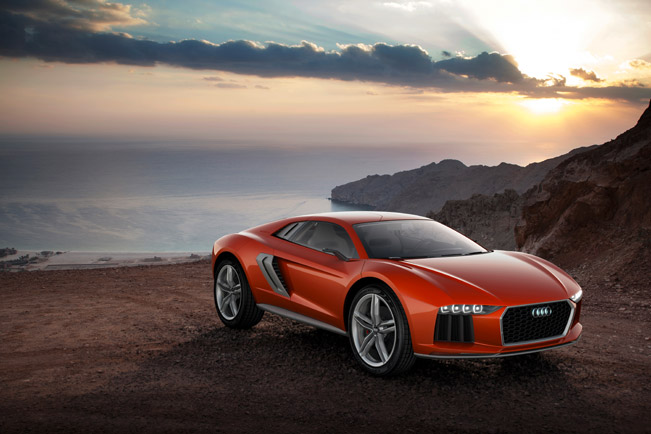Frankfurt Motor Show: Audi nanuk quattro concept
 Audi is currently showing the Audi nanuk quattro concept in Frankfurt. The car was in collaboration with the designers from Italdesign Giugiaro. The result is a sports car that can stand out equally at home on the race track.
Audi is currently showing the Audi nanuk quattro concept in Frankfurt. The car was in collaboration with the designers from Italdesign Giugiaro. The result is a sports car that can stand out equally at home on the race track.
This concept mixes the dynamics of a mid-engine sports car with the versatility of a sporty recreational vehicle. Born as a two-seater, it is powered by the V10 TDI engine installed longitudinally in front of the rear axle.
It has the capability to produce over 400 kW (544 hp) and 1,000 Nm (737.56 lb-ft) of torque to the crankshaft from just 1,500 rpm. Its twin-turbo register charging unit is controlled via the Audi valvelift system (AVS). The engine is matched with a seven-speed S tronic transmission, which is positioned behind the powertrain.
Nanuk quattro concept has a dry weight of circa 1,900 kilograms (4,188.78 lb). Thanks to this and to the powerful engine it can accelerate from 0 to 100 km/h (62.14 mph) in 3.8 seconds on its way to a top speed of 305 km/h (189.52 mph).
The car runs on 22-inch wheels which are coupled with 235/50 tires at the front and 295/45 at the rear. The carbon fiber-ceramic brake discs are also used here and they can withstand high temperatures.
A technological highlight of the show car is the integral steering, which combines the proven Audi dynamic steering at the front axle. In this way it can intervene at the cornering limit for enhanced stability, with additional steering for the rear wheels.
The new quattro concept has a wheelbase of 2,710 millimeters (106.69 in). It is 4,541 millimeters (178.78 in) long, 1,990 millimeters (78.35 in) wide and 1,337 milli-meters (52.64 in) high. Its body is made of lightweight aluminum Audi Space Frame (ASF) and there are also included components made of carbon fiber-reinforced polymer (CFRP) that are painted in Extreme Red.
At the front one can see a very flat version of a hexagonal single-frame grille and a narrow aluminum frame which is around its insert. The dynamic daytime running lights used here also serve as dynamic turn signals. The headlights also incorporate the new Audi Matrix LED technology.
From the side, the one sees that the contours of the fenders dominate. The front contour forms a sharp blister edge, while the rear one extends like a wave over the wheel. In addition, the upper and lower sections of the door stick out while the center section is slightly recessed. The doors open upward. Instead of exterior mirrors there are wing-shaped cameras used.
At the rear of the car can be seen a concave section that extends across the entire width and incorporates the Audi rings. The third brake light here runs as a flat strip between the tail-lights. In addition, the diffuser includes two large and round tailpipes of the exhaust system.
Furthermore, at the rear is a large rear window through which the TDI engine can be viewed.
Next, the interior of the Audi nanuk quattro concept includes a design which focuses on the instrument cluster. A carbon island accentuates the cockpit. The instrument panel highlights the horizontal lines and the width of the car and it is supported by aluminum stirrups at the center console.
The center tunnel console and the steering wheel house all of the control elements, the electronically controlled air suspension, the touchwheel for navigation and multimedia functions and the turn signals.
What is more, the show car is equipped with a freely programmable instrument cluster. This means that the driver can evoke a range of displays and information. Two small monitors in the area of the A-pillars serve as digital exterior mirrors and display the images from the cameras on the doors. The rearview mirror is replaced by the center display mounted on the headlining.
The instrument panel, the seats, the arm rests and door panels are covered in fine mineral gray leather. Another material used in the interior of the Audi nanuk quattro concept is CFRP.
Source: Audi










